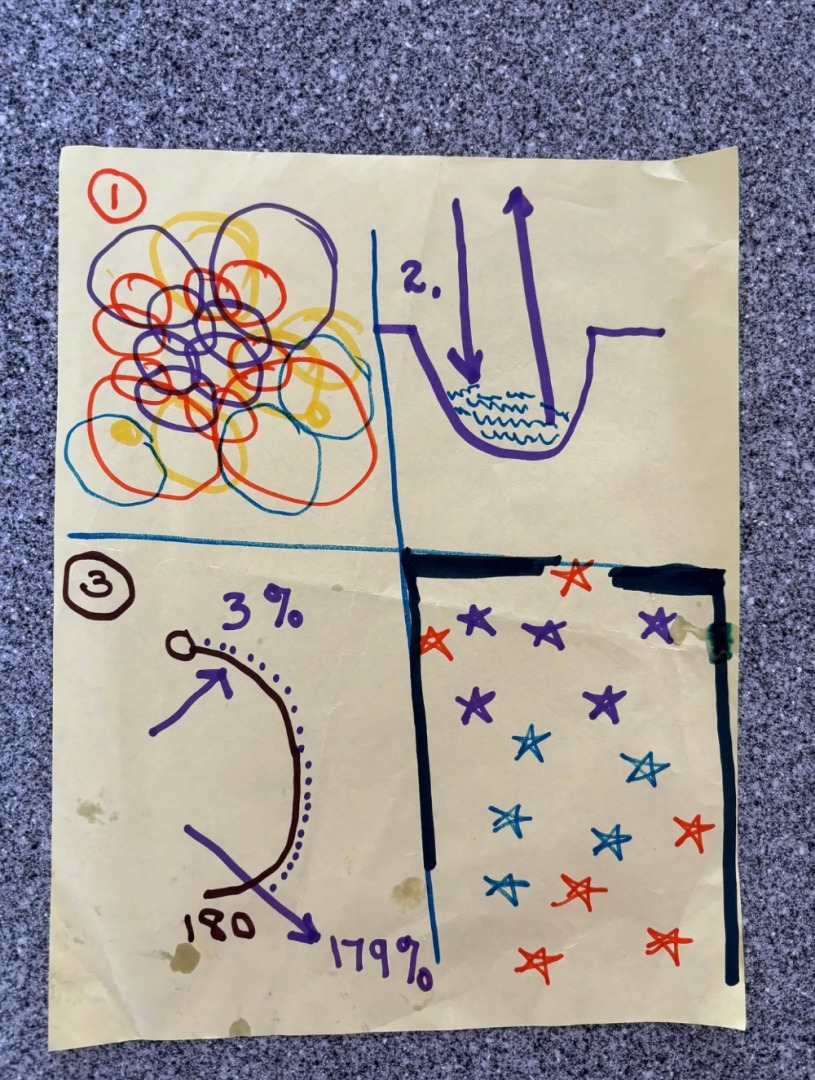
The Four Quadrants for Introductions and as a Tool for Problem Solving and Self-Reflection
Many of you may be aware (I was not until a recent gathering sponsored by Rutgers Graduate School of Education MSI Mentoring Program) that there is a “different” way to do introductions among attendees at an event.
Most times, folks go around and “speak” an introduction. And, these can go on and on. Some folks to be sure just say their name and title; others give a mini-bio. This all takes time and to be candid, they are rarely revelatory and certainly rarely memorable.
The 4 Quadrants approach starts with everyone drawing lines on a piece of paper to create 4 quadrants. No shock there. Then, the convenor asks participants to DRAW responses to 4 posed questions (I’ll get to those in a moment). No words; drawings only. Participants are given 10 minutes to prepare their drawings. And then, each attendee has two minutes to share their drawings.

Now, I do lots of art but for many, the idea of drawing takes them right out of their comfort zone. As in totally out. You can hear the whispers: I can only make stick figures….I can’t draw. There is a muttering among folks. There is a sense that, gee, can’t I just say my name and title?
Now, the questions for which the answers are drawn (as in actual drawing) can be varied and they can be adapted to the audience. At the event I attended (and my drawings are above) we were asked: (1) What do you hope to get out of this convening? (2) What do you bring to this convening? (3) What was a defining moment in your professional or personal life? and (4) What was a moment of great pride in your professional or personal life?
I am going to leave my answers out for the moment. Here’s the point: the exercise allows one to self-reflect and then share things that matter in a way that is symbolic or representational or unusual. Clearly that is a better way of getting to know attendees than simply sharing one’s name, title and geographic location. And, for me, the exercise has more power than being used as a clever and fun and fruitful opening event exercise. (To be sure, it only works with a group of under 30 people if sharing is happening).
Consider this as a classroom exercise on any given day with students of any age or stage. Ponder questions like: How do you feel today? What part of the assignment was most difficult? Easiest? Where would you like to be now?
Then, it could be used in counseling or advising sessions, both for adults and kids. Ponder questions like: Share one positive you are feeling now. Share one negative you are feeling now. Where do you see yourself in a year? If you could do one fun thing tomorrow, what would it be?
And, this quadrant approach could be used when one is alone and struggling with a problem. Rather than thinking in circles (so to speak) or obsessing, imagine posing questions for oneself that would be answered with illustrations, not words. And, just moving from words to pictures can break a cycle of thought/obsessing/pondering/agonizing.
I am reminded of Temple Grandin’s book Visual Thinking. She observes that many people are not visual thinkers; they are linguistic thinkers. She shares the differences and suggests we recognize the presence and power of visual thinking. It literally and figuratively adds dimension to any subject. Engaging both linguistic and visual thinkers can lead also to improved problem solving.
To that end, ponder the 4 quadrant approach if one is struggling in one’s place of employment. If asked to illustrate the answers to these four questions, one might garner some insight as to whether it is the job or the leader or the location or other personal factors that is/are causing the negativity.
Sample questions for this type of situation might be: (1) What is one positive about your job?; (2) What is one negative about your job?; (3) What is your North Star?; and (4) If you were fired tomorrow, how would you feel? And that’s just a starter list.
Suppose one is in an interpersonal relationship that is not working ideally, whether that is a friendship or a romantic partnership. Consider these “quadrant” questions: (1) What is something you admire in the relationship you are having?; (2) What is something that is bothering you in the relationship you are having?; (3) What is something that would improve the relationship you are having?; and (4) Where do you think the relationship will be in five years (stronger, weaker, non-existent, thriving)?
Bottom line here: the use of the visual can help use identify both ourselves (as a means of introduction) and to enable us to address some of the thorny issues we encounter in our individual and collective lives.
And, as to my answers in the drawing above, I’ll leave those for another post but perhaps you can guess at least some of them. Draw on………
Note: A special thank you to Professor Marybeth Gasman who introduced me to this exercise. She is an amazing leader.
Trending
-
1 Jocko Willink's Inspirational Life & Net Worth
Aaqil Ashraf -
2 How Art Shapes Culture and Reflects Human Experience
Luke Fitzpatrick -
3 Meet Felix Williams and Maria Arthuer: The Parents of World Class Winger Nico Williams
Felix Yim -
4 Kai Cenat's Dad and the Enduring Public Interest
Aaqil Ashraf -
5 London Tube Stations Closed as Workers Stage Strikes
Mihir Gadhvi





Comments